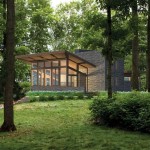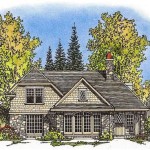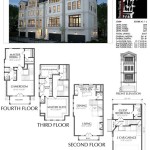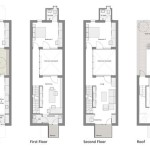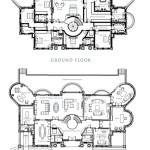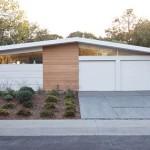An elevation plan of a house is a technical drawing that displays the vertical faade of a structure, typically along one of its sides. It conveys the height, proportions, and architectural details of the property from a specific perspective, allowing viewers to visualize the building’s overall appearance. For instance, an elevation plan of a Victorian-style house might emphasize its ornate gables, bay windows, and decorative trim.
Elevation plans play a vital role in home design and construction. They assist architects, engineers, and builders in coordinating various aspects of a project, including material selection, window placement, and structural integrity. By providing a comprehensive view of a building’s exterior, elevation plans ensure that all elements align harmoniously and meet aesthetic and functional requirements.
In the following sections, we will delve into the different types of elevation plans, their essential components, and how they aid in the planning and construction of a house.
Here are 8 important points about elevation plans of a house:
- Defines exterior appearance
- Shows height and proportions
- Includes windows and doors
- Conveys architectural details
- Assists in material selection
- Helps coordinate construction
- Ensures aesthetic harmony
- Meets functional requirements
Elevation plans are essential for effective home design and construction, providing a clear blueprint for the building’s vertical facade.
Defines exterior appearance
An elevation plan of a house provides a detailed representation of the building’s exterior appearance, allowing viewers to visualize its overall form and architectural style. It accurately portrays the height, width, and depth of the structure, along with the placement and dimensions of windows, doors, and other features.
The elevation plan captures the building’s overall aesthetic, including the interplay of lines, shapes, and textures. It conveys the architectural details that define the home’s character, such as decorative moldings, intricate window frames, and unique rooflines. By presenting a comprehensive view of the exterior, the elevation plan guides the selection of materials, colors, and finishes that will enhance the building’s visual appeal and curb appeal.
Elevation plans are particularly useful in the early stages of home design, enabling architects and homeowners to experiment with different design options and visualize how the house will look from various angles. They help ensure that the exterior appearance aligns with the desired aesthetic and functional requirements, creating a harmonious and visually pleasing structure.
Moreover, elevation plans facilitate communication between architects, builders, and other professionals involved in the construction process. By providing a clear and comprehensive visual representation of the exterior, elevation plans minimize misunderstandings, reduce errors, and streamline the construction process.
Shows height and proportions
An elevation plan of a house provides an accurate representation of the building’s height and proportions, allowing viewers to visualize the scale and overall dimensions of the structure. It conveys the vertical extent of the building from the ground level to the roofline, capturing the relationship between the height of different elements and the overall massing of the house.
The elevation plan clearly indicates the number of stories in the building and the height of each story. It shows the proportions of the different sections of the house, such as the relationship between the height of the roof and the height of the walls, and the balance between the width and height of windows and doors. By understanding the height and proportions of the building, architects and homeowners can create visually harmonious and well-proportioned structures.
Elevation plans are particularly useful in evaluating the overall scale and massing of a house in relation to its surroundings. They help ensure that the building fits appropriately within the context of the neighborhood and the surrounding landscape. By considering the height and proportions of the house in relation to neighboring buildings and natural features, architects can design structures that are visually compatible and respectful of the local environment.
Furthermore, elevation plans assist in determining the appropriate placement of windows, doors, and other openings in the building’s facade. By carefully considering the height and proportions of these elements, architects can optimize natural light and ventilation, enhance the building’s energy efficiency, and create visually appealing and functional spaces.
Includes windows and doors
An elevation plan of a house includes a detailed representation of all windows and doors in the building’s facade. It shows the size, shape, and placement of these openings, providing a clear understanding of how they contribute to the overall appearance and functionality of the house.
- Window placement and size: The elevation plan indicates the location and dimensions of all windows in the building. It shows how windows are arranged in relation to each other and to other elements of the facade, such as doors, balconies, and decorative features. Architects carefully consider window placement to optimize natural light and ventilation, enhance the building’s energy efficiency, and create visually appealing spaces.
- Door placement and size: The elevation plan also includes the placement and dimensions of all doors in the building. It shows the location of entry doors, patio doors, garage doors, and any other types of doors. Door placement is crucial for ensuring accessibility, functionality, and security. Architects consider factors such as traffic flow, privacy, and the overall design concept when determining door placement.
- Window and door styles: The elevation plan can also convey the style of windows and doors used in the building. It can show whether windows are single-hung, double-hung, casement, or bay windows. Similarly, it can indicate the style of doors, such as traditional, modern, or rustic. By including window and door styles, the elevation plan helps visualize the overall aesthetic of the building’s exterior.
- Relationship to other elements: The elevation plan shows how windows and doors relate to other elements of the facade, such as balconies, porches, and decorative features. It helps architects and homeowners visualize how these elements work together to create a cohesive and visually appealing exterior.
Overall, the inclusion of windows and doors in an elevation plan provides a comprehensive understanding of the building’s fenestration and access points. It assists in evaluating the functionality, aesthetics, and overall design of the house.
Conveys architectural details
An elevation plan of a house conveys a wealth of architectural details that define the building’s character and aesthetic appeal. It captures the intricate elements that contribute to the overall design concept, providing a comprehensive understanding of the building’s architectural style.
- Rooflines and dormers: The elevation plan clearly shows the shape and pitch of the roof, as well as the placement and style of dormers. These elements significantly impact the building’s overall appearance and can convey a particular architectural style, such as Victorian, Colonial, or Modern. Architects carefully consider rooflines and dormers to enhance the visual appeal of the house and to optimize natural light and ventilation.
- Moldings and trim: The elevation plan includes details of moldings and trim around windows, doors, and other features of the facade. These elements add depth, character, and visual interest to the building’s exterior. The type and style of moldings and trim can vary widely, from simple and understated to ornate and elaborate. They contribute to the overall architectural style and can create a sense of elegance and sophistication.
- Columns and pilasters: The elevation plan may also show columns or pilasters, which are vertical supports that add a touch of grandeur and symmetry to the building’s facade. These elements are often used to frame entryways, support porches, or divide different sections of the exterior. Columns and pilasters can be made from various materials, such as wood, stone, or brick, and their style can range from classical to contemporary.
- Decorative elements: The elevation plan can include details of decorative elements, such as cornices, pediments, and friezes. These elements add visual interest and can convey a specific architectural style. For example, a cornice might feature intricate moldings and dentils, while a pediment might display a sculpted relief or a decorative arch.
Overall, the elevation plan provides a detailed representation of the architectural details that define a house’s exterior appearance. It captures the interplay of lines, shapes, and textures, allowing viewers to appreciate the building’s unique character and architectural style.
Assists in material selection
An elevation plan of a house assists in the selection of materials for the building’s exterior by providing a detailed representation of the facade. It helps architects and homeowners visualize how different materials will look on the building and how they will complement the overall design concept.
- Exterior cladding: The elevation plan shows the areas of the facade that will require exterior cladding, such as siding, stone, or brick. Architects and homeowners can use the plan to determine the quantity and type of cladding materials needed, as well as to evaluate how different materials will affect the building’s overall appearance and durability.
- Roofing materials: The elevation plan also indicates the roof area and pitch, which helps in selecting appropriate roofing materials. Architects and homeowners can use the plan to determine the type of roofing material, such as shingles, tiles, or metal, that will best suit the building’s architectural style and climate. They can also calculate the quantity of roofing materials required.
- Windows and doors: The elevation plan shows the size, shape, and placement of windows and doors, which aids in the selection of appropriate materials for these elements. Architects and homeowners can determine the type of window frames, such as wood, vinyl, or aluminum, and the style and material of doors, such as solid wood, fiberglass, or steel.
- Decorative elements: If the building’s facade includes decorative elements, such as columns, moldings, or trim, the elevation plan provides information on their size and placement. This information helps in selecting appropriate materials for these elements, such as wood, stone, or composite materials, and in determining how they will be integrated into the overall design.
Overall, the elevation plan is a valuable tool for making informed decisions about the materials used in the construction of a house. It allows architects and homeowners to visualize the building’s exterior and to select materials that will enhance its aesthetic appeal, functionality, and durability.
Helps coordinate construction
An elevation plan of a house plays a crucial role in coordinating the construction process by providing a detailed and comprehensive representation of the building’s exterior. It serves as a visual guide for contractors and builders, helping them understand the design intent and ensuring that all elements of the facade are constructed accurately and in accordance with the plans.
The elevation plan helps coordinate the installation of windows and doors by clearly indicating their size, shape, and placement. This information guides the selection of appropriate window and door units and ensures that they align correctly with the framing and other elements of the facade. Proper window and door installation is essential for maintaining the building’s structural integrity, energy efficiency, and overall functionality.
Furthermore, the elevation plan assists in coordinating the exterior cladding process by providing details on the materials, patterns, and installation methods. It helps contractors determine the quantity and type of cladding materials required, as well as the appropriate techniques for installing them. Accurate cladding installation is crucial for protecting the building from weather elements, ensuring durability, and achieving the desired aesthetic appearance.
The elevation plan also facilitates the coordination of decorative elements, such as moldings, cornices, and trim. It provides information on their size, shape, and placement, guiding the selection and installation of these elements to enhance the building’s visual appeal and architectural style. Proper installation of decorative elements not only enhances the aesthetics but also contributes to the overall structural integrity and weather resistance of the facade.
Overall, the elevation plan serves as a valuable tool for coordinating the construction process of a house. It provides a clear and comprehensive visual representation of the building’s exterior, enabling contractors and builders to work together effectively and ensure that the final product aligns with the design intent and meets the desired aesthetic and functional requirements.
Ensures aesthetic harmony
An elevation plan of a house is crucial for ensuring aesthetic harmony in the building’s exterior design. It provides a comprehensive representation of the facade, allowing architects and homeowners to visualize how all elements will come together and create a cohesive and visually appealing appearance.
The elevation plan helps align the exterior design with the overall architectural style of the house. It ensures that the facade complements the roofline, windows, doors, and other features, creating a harmonious and unified look. By carefully considering the proportions, scale, and balance of the facade, architects can design an aesthetically pleasing exterior that reflects the desired architectural style.
Furthermore, the elevation plan assists in coordinating the colors, textures, and materials used on the facade. It allows architects and homeowners to visualize how different materials, such as stone, brick, wood, and siding, will interact with each other and contribute to the overall aesthetic. By carefully selecting and combining materials, architects can create a visually appealing and cohesive exterior that enhances the building’s curb appeal and blends seamlessly with the surrounding environment.
The elevation plan also helps ensure that decorative elements, such as moldings, cornices, and trim, are incorporated tastefully into the facade. It allows architects and homeowners to visualize how these elements will enhance the building’s character and contribute to its overall aesthetic appeal. By carefully considering the size, shape, and placement of decorative elements, architects can create a balanced and visually pleasing exterior that reflects the desired architectural style.
Overall, the elevation plan plays a vital role in ensuring that the exterior of a house is aesthetically harmonious and visually appealing. It provides a comprehensive representation of the facade, allowing architects and homeowners to visualize and coordinate all elements to create a cohesive and unified design that aligns with the desired architectural style and enhances the building’s overall appeal.
Meets functional requirements
An elevation plan of a house not only enhances the aesthetic appeal of a building but also plays a crucial role in meeting its functional requirements. It ensures that the building’s exterior design aligns with practical considerations, creating a functional and livable space.
The elevation plan helps ensure that windows and doors are placed strategically to optimize natural light and ventilation. By carefully considering the size, shape, and placement of windows, architects can maximize daylighting, reduce reliance on artificial lighting, and create a more energy-efficient building. Similarly, the placement of doors should consider accessibility, traffic flow, and security, ensuring that the building is easy to navigate and secure.
Furthermore, the elevation plan assists in designing a facade that protects the building from the elements. It helps architects select appropriate materials and construction methods to withstand specific climatic conditions, such as extreme temperatures, high winds, or heavy rainfall. By considering factors like insulation, weather resistance, and drainage, architects can design an exterior that safeguards the building’s occupants and interior spaces from the elements.
Additionally, the elevation plan aids in incorporating functional elements into the facade, such as balconies, patios, and porches. These elements extend the living space outdoors, providing opportunities for recreation, relaxation, and entertainment. By carefully considering their size, shape, and placement, architects can create functional and inviting outdoor areas that enhance the overall livability and enjoyment of the house.
Overall, the elevation plan of a house is not merely a design tool but also a functional document that ensures the building meets practical requirements. It helps architects create a facade that optimizes natural light, ventilation, and protection from the elements, while also incorporating functional elements that enhance the livability and enjoyment of the house.










Related Posts


